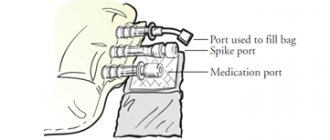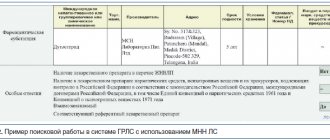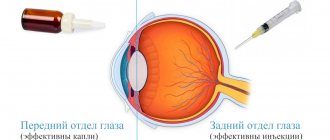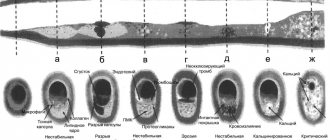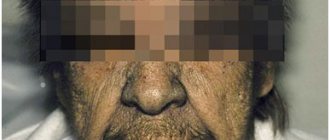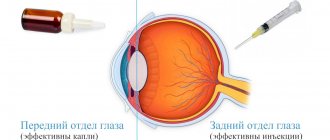Normative base
The general norm establishing the basic requirement for the prescription of drugs is fixed in Part 15 of Art. 37 of the Federal Law of November 21, 2011 No. 323-FZ “On the fundamentals of protecting the health of citizens in the Russian Federation.” Thus, from this norm it follows that drugs must be prescribed in accordance with the standards of medical care and clinical recommendations. If the drug is not included in the relevant standard of medical care or is not provided for by the corresponding clinical recommendation, then its prescription is allowed in the case of medical indications (individual intolerance, for health reasons) by decision of the medical commission.
The main regulation of the issues of prescribing medications is established by Order of the Ministry of Health of Russia dated January 14, 2019 No. 4n (hereinafter referred to as Order No. 4n).
The said order approved:
- The procedure for prescribing medicines (hereinafter referred to as the Procedure for Prescribing Medicines) (establishes the rules for prescribing medicines for medical use and processing their prescription when providing medical care in medical organizations);
- Forms of prescription forms for drugs: No. 107-1/u
- No. 148-1/u-88
- No. 148-1/u-04 (l)
Let us recall that the procedures and forms introduced by Order No. 4n began to be applied on April 7, 2022 and replaced the previously valid similar documents, which were approved by Order of the Ministry of Health of Russia dated December 20, 2012 No. 1175n (hereinafter referred to as Order No. 1175n). Order No. 1175n, accordingly, became invalid on April 7, 2022.
Note: detailed information on the differences in the requirements of Order No. 4n and Order No. 1175n is presented in the article by the Faculty of Medical Law “New procedure for prescribing drugs for medical use.”
The rules of Order No. 4n are also supplemented by other regulatory legal acts that relate to more specific cases, for example:
- Order of the Ministry of Health and Social Development of Russia dated February 12, 2007 No. 110 “On the procedure for prescribing and prescribing medicines, medical products and specialized medical nutrition products” (in accordance with this order, or rather in accordance with the Instructions approved by it on the procedure for prescribing medicines and processing prescriptions and requirements - invoices, medications are prescribed when providing medical care in a hospital setting in the invoice requirements sent to pharmacy organizations, which are structural divisions of the medical organization in which medical care is provided);
- Order of the Ministry of Health of Russia dated 08/01/2012 No. 54n “On approval of the form of prescription forms containing the prescription of narcotic drugs or psychotropic substances, the procedure for their production, distribution, registration, accounting and storage, as well as registration rules” (hereinafter referred to as Order No. 54n) (in In accordance with this order, a special prescription form for narcotic drugs and psychotropic substances is issued (according to Form No. 107/u-NP)).
List of necessary medications in a home medicine cabinet
The composition of a first aid kit is individual in each home, but there are certain groups of drugs that every person should have on hand. They will help provide first aid until the doctor arrives or wait until the morning to contact specialists. But your home medicine cabinet should not include products that are used very rarely.
A first aid kit for use at home should include three main groups of medications:
- means for treating wounds and dressings;
- necessary medications;
- auxiliary medical products.
The last group includes tweezers, clean scissors that can be used to cut a bandage or plaster. The necessary components include a thermometer, mercury or electronic, and a tonometer. If you have a small child at home, you can purchase an infrared thermometer.
Who prescribes medications
The prescription of medicines can be carried out by the following entities (clause 2 of the Procedure for prescribing medicines):
- attending physician;
- paramedic;*
- midwife;*
- an individual entrepreneur engaged in medical activities.
Further in this article, these subjects are referred to as medical workers.
* A paramedic and midwife have the right to prescribe medications only if they are vested with the powers of the attending physician in accordance with the Procedure established by Order of the Ministry of Health and Social Development of Russia dated March 23, 2012 No. 252n.
General requirements for prescribing medications and filling out prescriptions
The general requirements for the prescription of drugs are established in clauses 2 – 26 of the Procedure for prescribing drugs. Note that the most important of them include the following:
- Registration of drug prescription
, incl. subject to manufacture and dispensing by pharmacies (hereinafter referred to as individually manufactured drugs),
carried out
by a medical professional in the name of the patient* for whom the drug is intended,
on a prescription form drawn up on paper with your signature, and (or) with the consent of the patient or his legal representative
on a prescription form
in the form of an electronic document using an enhanced qualified electronic signature of a medical worker
(clauses 3 and 7 of the Procedure for Prescribing Medicines).Please note that a prescription in the form of an electronic document containing the prescription of narcotic drugs or psychotropic substances must be signed not only using an enhanced qualified electronic signature of a medical worker, but also using an enhanced qualified electronic signature of the relevant medical organization.
An electronic prescription must be generated using the state information system in the healthcare sector of a constituent entity of the Russian Federation, the medical information system of a medical organization (clause 7 of the Procedure for Prescribing Medicines).
It should be taken into account that the registration of prescriptions in the form of electronic documents can only be carried out if the authorized executive body of a constituent entity of the Russian Federation makes a decision on the use in the territory of this subject of prescriptions for medicines generated in the form of electronic documents (clause 3 of the Procedure for prescribing medicines) . That is, without the corresponding regional regulatory legal act, electronic prescriptions cannot be used on the territory of the corresponding constituent entity of the Russian Federation.
*Prescriptions on paper, drawn up on prescription forms No. 107-1/u, No. 148-1/u-88, No. 148-1/u-04 (l) and No. 107/u-NP, cannot be received without only by the patient himself and his legal representative, but also by a person who has a power of attorney from the patient for the right to receive such a prescription, issued in accordance with the civil legislation of the Russian Federation. The fact of issuing a prescription for a drug to a legal representative or authorized person is subject to recording in the patient’s medical records
(Clause 7 of the Procedure for Prescribing Medicines).
- Information about the prescribed drug
(name of the drug, dosage, route of administration and use, dosage regimen, duration of treatment and justification for prescribing the drug)
must be entered by a medical professional into the patient’s medical documentation
(clause 3 of the Procedure for Prescribing Drugs). - The drug is prescribed
medical worker
by international nonproprietary name, and in its absence - by group or chemical name. In the absence of an international nonproprietary name and a generic or chemical name of the drug, the drug is prescribed by trade name
.If there are medical indications (individual intolerance, for health reasons), by decision of the medical commission of the medical organization, the prescription and registration of the prescription of drugs that are not included in the standards of medical care, or by trade names are carried out (such a decision of the medical commission must be recorded in the patient’s medical documentation and in journal of the medical commission) (clause 6 of the Procedure for prescribing medications).
- The composition of the drug, the dosage form and the request from the medical worker to the pharmacist about the dispensing of the drug are drawn up
in Latin in the genitive case. When preparing prescription forms, the use of abbreviations is allowed (established in Appendix 2 to the Procedure for Prescribing Medicines). When prescribing a drug, it is not allowed to abbreviate the ingredients that make up the drug with similar names, which do not allow one to determine which drug is prescribed (clause 17 of the Procedure for Prescribing Drugs). - The method of administration of the drug
is indicated indicating the dose, frequency, time of administration relative to sleep (morning, at night) and its duration, and for drugs that interact with food, the time of their use relative to meals (before meals, during meals, after meals ) (Clause 18 of the Procedure for Prescribing Medicines). - When registering a prescription for a finished drug, the amount of active ingredients in the prescription is indicated in accordance with the instructions for medical use of the drug. And when registering a prescription for an individually manufactured drug, the amount of solid and bulk pharmaceutical substances is indicated in the prescription in grams (0.001; 0.5; 1.0), liquid - in milliliters, grams and drops (clause 20 of the Procedure for Prescribing Drugs).
- Medical workers are prohibited from issuing prescriptions for
(clause 8 of the Procedure for Prescribing Medicines): medicines in the absence of medical indications; - Medicines not registered on the territory of the Russian Federation;
- Medicines that, in accordance with the instructions for medical use, are used only in medical organizations;
- for narcotic drugs and psychotropic substances included in List II of the List of narcotic drugs, psychotropic substances and their precursors subject to control in the Russian Federation, approved. By Decree of the Government of the Russian Federation of June 30, 1998 No. 681 (hereinafter referred to as the List), registered as medicines for the purpose of use for the treatment of drug addiction.
Individual entrepreneurs carrying out medical activities, in addition to the prohibitions presented, are prohibited from issuing prescriptions for narcotic drugs and psychotropic substances included in Lists II and III of the List.
Please note that a prescription issued in violation of the requirements established by the Procedure for Prescribing Medicines is considered invalid (clause 26 of the Procedure for Prescribing Medicines).
Note: The procedure for prescribing medications separately regulates the specifics of prescribing medications:
- when providing medical care in a hospital setting (clauses 27-31 of the Procedure for Prescribing Medicines);
- in the provision of primary health care, emergency medical care and palliative care (clauses 32-35 of the Procedure for prescribing medications);
- citizens who have the right to receive medicines free of charge or to receive medicines at a discount when providing primary health care (clauses 36-40 of the Procedure for prescribing medicines).
Information about the most important features of prescribing drugs in these cases is presented in the article of the Faculty of Medical Law “New procedure for prescribing drugs for medical use.”
According to WHO definition, the rational use of drugs (drugs) is their use when patients receive drugs in accordance with clinical need, in doses that meet individual needs, for an adequate period of time and at the lowest cost for themselves and society (1985) .The problem of irrational use of drugs In the world, more than 50% of drugs are prescribed, dispensed or sold inappropriately, half of patients do not use them properly, and a third of the world's population does not have access to necessary medications. The most common types of irrational use of drugs include (WHO, 2002): • simultaneous prescription of a large number of drugs to a patient (polypharmacy); • inadequate use of antibacterial drugs, often for non-bacterial infections; • excessive use of injections in cases where oral forms of drugs are more suitable for treatment; • non-compliance with the provisions of clinical guidelines when prescribing drugs; • improper use of drugs (self-medication), including prescription drugs. Insufficient access to drugs and their use in inadequate doses have a significant impact on the level of morbidity and mortality, especially in the treatment of childhood infections and chronic diseases, in particular arterial hypertension, diabetes mellitus, epilepsy, and mental disorders. Unjustified or excessive use of drugs causes unreasonable additional costs for the patients themselves and causes significant damage to their health (unfavorable treatment outcomes, development of adverse reactions). Excessive use of antibiotics increases the resistance of microorganisms; injections under unsterile conditions lead to infection with hepatitis, HIV/AIDS and other blood-borne diseases. Finally, the irrational use of drugs often increases the demand among patients for certain medications, leads to the depletion of material resources and patients lose confidence in the health care system.
Assessing the problem of irrational use of drugs To solve the problem of irrational use of drugs, it is necessary to regularly monitor their prescription, dispensing and use by patients in order to establish: • the type of irrational use (in order to develop a strategy to change a specific situation); • number of cases of waste (to give an idea of the scale of the problem and evaluate the strategies used); • reasons for irrational use (to select appropriate effective strategies to eliminate them). Quite often, there are very specific reasons for the irrational use of drugs, such as a lack of knowledge and skills of the doctor, independent information, unlimited availability of drugs, excessive staff employment, inadequate advertising of drugs, and financial motivation for their sales. To study the problems encountered with the use of specific drugs for certain diseases, especially in clinics, drug consumption studies are conducted. Quantitative techniques used in sociology (focused discussions, in-depth interviews, structural observations, special questionnaires) can be used to assess the causes of irrational use of drugs. The data obtained in this way is used to develop appropriate measures to improve the effectiveness of drug use. WHO, together with partners, conducts various international courses to train specialists in assessing the use of medicines and implementing activities that promote more rational use of medicines.
Key activities to promote rational use of medicines The modern definition of rational use of medicines was approved at an international conference in Kenya in 1985. In 1989, the International Network for the Rational Use of Medicines (IDN) was created to conduct interdisciplinary research projects that promote more effective use of medicines (This e -mail address is protected from spambots; to view it you must have Javascript enabled, https://www.msh.org/inrud). Subsequently, WHO/MSRIL indicators were developed to examine drug use in primary care. There are still many gaps in our knowledge about the most effective policies and strategies to improve the use of medicines. Below are the main directions and activities that contribute to a more rational use of drugs.
Twelve Key Points for the Rational Use of Medicines
1. The presence of an interdepartmental government body coordinating the principles of drug prescription.
2. Use of clinical guidelines.
3. Application of a list of necessary medications, compiled on the basis of the best standards of treatment.
4. Organization and effective work of medicinal and therapeutic committees in regions and hospitals.
5. Teaching pharmacotherapy using a problem-oriented method to students in universities.
6. Postgraduate medical education is the main requirement for licensing/certification of medical workers.
7. Conducting supervision, auditing and providing feedback when monitoring the use of medicines.
8. Independent information about medications.
9. Educating the public and providing reliable information about medicines.
10. Preventing the realization of selfish financial interests.
11. Clear regulation of the use of drugs.
12. Sufficient government funding to ensure the availability of medicines, training and effective work of medical personnel. 1. Mandatory interdisciplinary government body coordinating the principles of drug prescribing. The use of drugs is determined by many factors depending on the health care system, the training of health workers, etc. This requires a multidisciplinary approach to develop, implement and monitor interventions that promote more rational use of drugs. The State Regulatory Authority (GRA) is the agency that develops and implements most legal and administrative regulations for drugs. Ensuring the rational use of drugs requires a lot of effort and coordination of actions of all entities in the field of drug circulation. A dedicated government organization is needed to coordinate policies and strategies for the use of medicines at the national level, in the public and private sectors. The form of this organization may be different in different countries, but it should include representatives of the state (Ministry of Health), medical specialists, employees of the State Grocery Organization and the pharmaceutical industry, non-governmental organizations working in the field of health care, and consumers. An integrated approach to solving a problem ensures greater success than single measures. 2. Clinical guidelines Clinical guidelines (standards of treatment, recommendations for prescribing medications) consist of systematically developed provisions that help specialists make the right decisions in the treatment of specific diseases. Clinical guidelines based on evidence-based medicine are essential for the rational use of medicines. First, they contain diagnostic and therapeutic standards against which actual treatment results can be compared; secondly, they are a proven way to implement rational use of medicines, provided that they are developed with the participation of practitioners, are easy to read, officially approved, widely disseminated and verified through audits, with feedback from users. Guidelines should be developed for each level of healthcare (from paramedics at primary level to specialists in leading centers), taking into account the prevailing conditions and the skills of staff. The use of evidence-based medicine and regular updating of information increases the level of confidence of doctors in treatment recommendations. 3. List of necessary drugs based on the drugs of choice Drugs that meet the key medical needs of the population are necessary. The List of Essential Medicines (LIST) facilitates the management of medicines circulation in all respects: procurement, storage and distribution of medicines with a smaller number of items. Prescribing drugs becomes more rational if the doctor has to store information about fewer drugs in memory. State PNL should be based on the recommendations of state clinical guidelines, the selection of drugs should be carried out by a centralized committee, whose members use clear, pre-agreed criteria based on data on the effectiveness, safety, quality, price of the drug, which may vary by region, and the price/price ratio. efficiency. PNL must be regularly updated, their implementation is officially approved. The provision and distribution of medicines in the public sector should be limited to those included in the PNL. Ensure that only those employees authorized to handle them have access to certain medications. Government activities in the pharmaceutical sector (quality control, insurance reimbursement, personnel training) should focus on PCNL. A sample list of required drugs, developed by WHO, helps in drawing up your own PNL in various countries. 4. Drug and Therapeutic Committees in Regions and Hospitals Drug and Therapeutic Committees (DTCs), known as pharmacotherapeutic committees, are responsible for ensuring the safe and effective use of drugs in a region or institution. In industrialized countries, such committees have been successful in promoting programs for more rational and effective use of drugs in hospitals.
Tasks of the drug and therapeutic committees
• Developing, implementing and meeting the needs of the institution or region.
• Selection of cost-effective and safe medications (clinic/regional drug formulary).
• Implement and evaluate interventions to improve drug use (including evaluation of drug use and collaboration with antibiotic and infection control committees).
• Continuous professional development of employees (use of training methods).
• Control of advertising information received by medical personnel from representatives of the pharmaceutical industry.
• Monitoring and measures to prevent adverse drug reactions and prescribing errors.
• Consultations on other issues related to medicines, in particular the quality of medicines and the costs of their purchase.
Government bodies promote the development of medical therapy in clinics, taking into account their activities during licensing and accreditation of a medical institution. Members of the LTK may include representatives of the major medical specialties and administration, and they must independently declare on record any conflicts or interests in relation to medicinal products. The chairman of the LTK is usually the chief physician, the secretary is a senior pharmacist. Factors that ensure the success of the LTK include: clarity of purpose, a strong mandate, support from clinical management, transparency of activities, broad representation, professional competence, interdisciplinary approach, and sufficient funding. 5. Problem-based training in pharmacotherapy within institute programs The quality of basic education in pharmacotherapy in a training program for future doctors and paramedics can significantly influence the prescription of medications. Rational training in pharmacotherapy, working with clinical guidelines and a list of required drugs helps future doctors develop good skills in prescribing medications. The effectiveness of training is higher if it is carried out on specific clinical examples (problem-oriented method), takes into account the knowledge and skills of students, and is aimed at developing in them an independent critical approach to prescribing medications. The WHO Guidelines for Quality Prescribing describe a method of teaching pharmacotherapy based on solving specific clinical problems, which has been successfully used in a number of medical schools in different countries. 6. Postgraduate medical education is a mandatory requirement for licensing and certification of medical workers. In many developed countries, postgraduate medical education (PME) is a mandatory requirement for confirming a license to practice medicine and certification of medical workers. However, in many developing countries, the availability of PMOs is limited and there is little incentive to obtain one, since it is not required for continued licensure. PME can be more effective if it is problem-based, more targeted, personalized and involves representatives from professional societies, universities and ministries of health. The use of printed materials, without direct teacher-trainee interaction, has been ineffective in changing prescribing patterns. PMO should be received not only by doctors and nursing staff, but also by specialists working in the information sector and in the field of drug sales. MIPs are often dependent on support from pharmaceutical companies because public funds are insufficient, but it should be noted that MIPs run by pharmaceutical companies are often biased. In this regard, public university departments and professional societies should be supported to conduct independent PME. 7. Supervision, audit and feedback To ensure high quality of treatment, supervision of the use of drugs is necessary. It involves personal communication between inspectors and medical professionals, support and increased education of the latter in the field of pharmacotherapy. This approach will be much more effective and better accepted by performers than inspection and punishment. Effective forms of supervision include auditing medication administration, providing feedback, comparing and discussing treatment results with colleagues. An audit of drug prescriptions and feedback is an analysis of the correctness of the prescriptions made, followed by a commission conclusion, which indicates which actions of the doctor differ from the actions taken in the guidelines, and other violations. In hospitals, this audit and feedback is known as medication utilization review. The collective approach involves doctors themselves identifying problems that arise when prescribing drugs in an institution and developing measures to solve them. This approach requires a coordinator responsible for organizing the work. 8. Independent information about drugs Often the only information doctors receive about drugs comes from pharmaceutical companies and can be biased, which is why independent (unbiased) information is so important. Drug Information Centers (DICs) and drug bulletins are two ways to disseminate information. They can be organized by the state or a university clinic under the supervision of a qualified specialist. CIL or newsletters must be independent from outside influences, including financial and other conflicts of interest, and use only information based on evidence-based medicine. The WHO sample formulary provides independent information on all drugs included in the WHO Essential Medicines List. 9. Patient awareness of medications Lack of sufficient knowledge about the benefits and risks of using medications, when and how to use them correctly, can lead to the patient not only not receiving the expected therapeutic effect, but also suffering from unwanted side effects. This applies to both doctor-prescribed medications and over-the-counter medications. The state must be responsible for the quality of medicines and information about them provided to the consumer and strictly monitor compliance with the following requirements. • Over-the-counter drugs should only be sold with adequate labeling and instructions that are clear and understandable to non-professionals. The instructions must indicate: the name of the drug, indications, contraindications, doses, interactions and warnings regarding careless use or storage. • Regulate and control advertising that appears on television, radio, newspapers, and the Internet and can misinform both consumers and prescribers of medicines. • Conducting educational campaigns for the population, taking into account public opinion and social factors. Education on the rational use of medications can be included as a component of health-improving activities for children in schools and adults in general education courses. 10. The influence of harmful financial factors on the use of drugs. The rational or irrational use of drugs can be significantly influenced by financial motives, the most common of which are the following. • Doctors who make money from selling drugs (distributing drugs) prescribe large quantities and the most expensive drugs, so the health care system should be organized in such a way that doctors who prescribe drugs do not have the opportunity to sell them. • Uniform tariffs for all drugs in any quantity within a single prescription lead to overprescription of medications, so tariffs should be by drug, not by prescription. • The tariff for drug dispensing, as a percentage of the cost of the drug, promotes the sale of more expensive drugs; Therefore, it is preferable to use the so-called flat tariff, which does not depend on the price of the medicine. Although, with reasonable policies, this could lead to higher prices for cheaper drugs and lower prices for more expensive ones. • Patients prefer free drugs or drugs whose cost is reimbursed to them. If the state provides free of charge or insurance companies reimburse only drugs included in the list of essential drugs, then patients will force doctors to prescribe them only these drugs. A system in which drugs are reimbursed only if prescriptions comply with clinical guidelines has a greater impact on rational prescribing. 11. Adequate regulation of the circulation of medicines To ensure the rational use of medicines, regulation of the activities of all subjects of medicines circulation is of great importance.
Regulatory measures to promote rational use of medicines
• Registration of drugs in order to permit the use in medical practice of only safe and effective drugs of high quality, prohibiting the use of ineffective and unsafe drugs.
• Certain restrictions on the use of certain medications, including the release of some drugs only by prescription.
• Educational standards and norms of conduct for medical personnel. Professional societies and universities have an important role to play in these processes.
• Certification of healthcare professionals (doctors, nurses, paramedics) in order to improve their skills in diagnosing diseases, as well as in the rational use of medications.
• Licensing of retail and wholesale points of sale of medicines in order to maintain standards of storage and dispensing of medicines.
• Adherence to ethical principles and impartiality in the regulation and control of drug information. Advertising must be reliable, accurate, truthful, informative, modern, based on evidence-based medicine. 12. Government funding: availability of drugs and training of medical personnel The lack of necessary drugs leads to the use of less effective and safe drugs. Without competent personnel and sufficient funding, it is impossible to implement any of the key components of the state program to promote the rational use of drugs. The adverse clinical outcomes and additional economic costs caused by irrational drug use are sufficient reasons for large public investments in programs to promote the rational use of drugs. The state is responsible for the necessary funding, public health must have enough qualified specialists, and the necessary medicines must be available to the entire population. Special programs are necessary for the especially needy and the poor, the implementation of these programs requires limited government purchases and necessary medicines, access to them by the population, as well as the provision of sufficient funding for quality education and salaries for staff. Drug stewardship and the use of information to develop, implement, and evaluate interventions to eliminate drug misuse are of paramount importance in every government program promoting rational drug use. For the successful implementation of such programs and coordination of activities, the creation of an interdepartmental government structure and sufficient government funding are especially important.
Source: rpt.health-ua.com
Forms of prescription forms and their validity periods
Prescriptions for drugs are drawn up on prescription forms in the following forms and with the following validity periods:
| Form No. | Medicines for which the form is intended | Validity period of a prescription issued in the appropriate form |
| No. 148-1/u-88 |
| 15 days from the date of registration - as a general rule* * The specified period does not apply to prescriptions issued for the prescription of narcotic and psychotropic drugs of List II of the List in the form of transdermal therapeutic systems, narcotic drugs of List II of the List containing a narcotic drug in combination with an opioid receptor antagonist, psychotropic drugs of List III of the List. At the same time, it is still unclear for how long prescriptions issued for such drugs are valid. For the treatment of patients with chronic diseases, prescriptions for barbituric acid derivatives, combined drugs containing codeine (its salts), and other combined drugs that are subject to subject-quantitative accounting of drugs with anabolic activity can be issued for a course of treatment of up to 60 days. |
| No. 148-1/u-04 (l) |
| 30 days from the date of registration - as a general rule 90 days from the date of registration - if the prescription is issued for a citizen who has reached retirement age, a disabled person of the first group, a disabled child, as well as a citizen suffering from a chronic disease requiring long-term treatment* * For the treatment of chronic diseases, these citizens may be given prescriptions for medications for a course of treatment of up to 90 days |
| No. 107-1/у |
| 60 days from the date of registration - as a general rule within up to 1 year - when prescribing ready-made drugs and individually manufactured drugs to patients with diseases requiring long-term course of treatment* * If the validity period of a prescription is established within the limits of up to 1 year, o is indicated in the prescription, the validity period of the prescription and the frequency of drug dispensing are indicated (weekly, monthly and other periods). Additionally, this instruction is certified by the signature and seal of a medical worker, as well as the seal of a medical organization “For prescriptions” (for a prescription on paper) or an enhanced qualified electronic signature of a medical worker and a person authorized to certify documents on behalf of a medical organization (for a prescription in the form of an electronic document ) |
| No. 107/u-NP |
| 15 days from the date of registration |
Note: forms No. 148-1/u-88, No. 148-1/u-04 (l) and No. 107-1/u and the rules for filling them out were approved by Order No. 4, and form No. 107/u-NP and its rules the fillings are established by Order No. 54n.
Wound treatment products
Minor household injuries, abrasions, cuts and minor burns can be treated independently without seeking help from a doctor. To do this, it is enough to make a home first aid kit properly. It necessarily includes several types of antiseptics and preparations for treating the skin. It is best to have hydrogen peroxide, iodine solution, and brilliant green at home. For washing wounds in adults and children, chlorhexidine, miramistin, and furacillin can be included in the list. Any of these antiseptics will help get rid of pathogenic bacteria on the skin. They are also used to treat the oral mucosa for colds.
The necessary components of a home first aid kit include various types of fixing and dressing materials. What minimum set should all homes have:
- large wide sterile bandage;
- small bandage;
- cotton wool or sterile non-woven bandages;
- elastic bandage;
- several types of patches.
If you have a child at home, you can buy a children's patch with funny pictures to cheer up after an abrasion. Special types of fixing bandages and patches against calluses and corns are purchased in the required quantity when injuries occur. It is not necessary to always keep them at home.
A necessary item in the home first aid kit is lidocaine anesthetic spray. It can be applied topically to bruises and sprains to reduce pain. Burn spray is also added to the list of preparations for treating wounds and dressings. It usually contains panthenol, which helps reduce pain and burning and accelerates skin recovery. But if the required drug is not included in the first aid kit, it is prohibited to apply oil or fat to the burn site.
Accounting and storage of prescription forms
Let us note that in each medical organization, by order of the head, a person must be appointed who is responsible for storing and recording all types of prescription forms.
For different forms of prescription forms, there are their own log books containing information regarding a given (specific) prescription form.
The rules for recording prescription forms in forms No. 107-1/u, No. 148-1/u-88 and No. 148-1/u-04(l) and information to be included in the log books of such prescription forms are established in clause 23, 24, 25 and 27 of the Procedure for Registration of the Republic of Belarus, approved. Order No. 4, and in relation to prescription forms in form No. 107/u-NP - in Appendix No. 4 to Order No. 54n.
The rules for storing prescription forms in forms No. 107-1/u, No. 148-1/u-88 and No. 148-1/u-04(l) are defined in clauses 28, 29, 30, 31, 32, 34 of the Registration Procedure RB, approved Order No. 4, and in form No. 107/u-NP - as well as the accounting rules for the latter - in Appendix No. 4 to Order No. 54n.
Please note that prescription forms to be recorded must be stored under lock and key in a metal cabinet (safe) or metal box.
